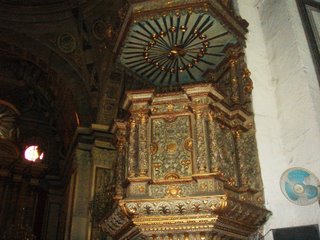A visit to Old Manila's churches
I had the tremendous opportity to visit Intramuros [ literally "within the walls" ], the "walled city" around three weeks ago. Intramuros, as some know, was the original Manila during Spanish times. Built in 1571 by the conquistadors Martin de Goiti, Juan Salcedo, and Miguel Lopez de Legaspi, Intramuros remains today a monumental symbol of past times, a forgotten shard of the ancient past thrust in the midst of a glittering megalopolis. One literally steps into a time machine upon entering the alled city-- here the police officers dress in the same manner as the guardia civil, complete with horses and period costume. Intramuros has historically been the home of the See of Manila; the Cathedral is located here, traditionally right next to the ayuntamiento or city hall. Pulpit, San Agustin church. Note the out of place fan
Pulpit, San Agustin church. Note the out of place fan
Another hallmark of Intramuros is the beautiful, if ostentatious San Agustin Church. Built and staffed by the Augustinian friars, San Agustin is one of the few churches which managed to escape the ravages of the Vatican II 'uglification'. Here one will find rows upon rows of images of saints, some carved from ivory. The main altar is made of beaten silver, if I am correct. But if tat weren't enough, there is a museum located next door, containing a truly beatific collection of Spanish era religious art. Among the treasures found here are statues of the saints made fromivory and lavished in gold-thread vestments, altar ornamentations, whole retablos [ altar screens ], vestments, and 400 year old psalters. No pictures were allowed, however. 
Right: Ceiling of San Agustin church
As well as these the church is gifted with a magnificent trompe-l'oeil ceiling. San Agustin is a favorite venue for weddings of manila's old money couples. Perhaps nothing recalls Manila's unique Spanish identity more than the fact that a good fraction of the confessionals in the church allow for penitents to confess in Spanish.
Left: Altar Mayor of San Agustin. The pictures odes not do it justice
The church is among four churches designated as UNESCO world heritage sites in the Philippines. The other three are, Santa Maria church in Ilocos, San Agustin church is Paoay, and Santo Tomas de Villanueva in Iloilo.
The Manila Cathedral is also in Intramuros. Also known as Minor Basilica of the Immaculate Conception, 'is the only cathedral in the world that was built and renovated six times. It was the seat of the Archbishop of Manila during the Spanish Colonial Period in the Philippines, and still remains to be the ecclesisastical seat of the Archdiocese of Manila.'
Source
'The See of Manila, with jurisdiction over all the Philippine Islands and suffragan to the See of Mexico, was erected in 1578. The first bishop, Domingo de Salazar (born 1512), arrived in Sept., 1581. Left: Statue of St. Peter, Manila Cathedral
Left: Statue of St. Peter, Manila Cathedral
The first cathedral, made of nipa and bamboos, was built in 1581. It was damaged by a typhoon in 1582 and razed by fire in 1583. The new cathedral, which was made of stone, was made in 1592. It was destroyed by an earthquake in 1600. The third cathedral, with three naves and seven chapels, was started in 1584 and blessed in 1614. It was toppled by another earthquake which shook Manila in 1645. The magnificent fourth cathedral was constructed in 1654 to 1671 under Archbishop Miguel Poblete. It was severely damaged in 1863 by a very strong earthquake that even toppled the Palace of the Governor General of the Philippines. In 1880, another earthquake toppled its bell tower and since then until in 1959, the cathedral remained towerless. '
'The fifth cathedral was constructed in 1870-1879. It was solemnly blessed in December of 1879. The center cross of the dome is a reference point of astronomical longitudes of the archipelago. The magnificent cathedral was toppled into ruins by the bombs of World War 2 in 1945.'
'The present cathedral was constructed in 1954 to 1958 under Archbishop Rufino Santos of Manila and under the supervision of National Artist for Architecture Awardee, Architect Fernando Ocampo. It was elevated into the rank Basilica Minore in 1981 by Pope John Paul II.'
Unfortunately, the lighting inside the Cathedral made it almost impossible to take a good picture. The main altar is dedicated to the Immaculate Conception, and there are numerous shrines and side altars dedicated to various Spanish saints. Among those interred in the Cathedral are Rufino Cardinal Santos, the first Filipino Cardinal, and the late, and much beloved Jaime Cardinal Sin















